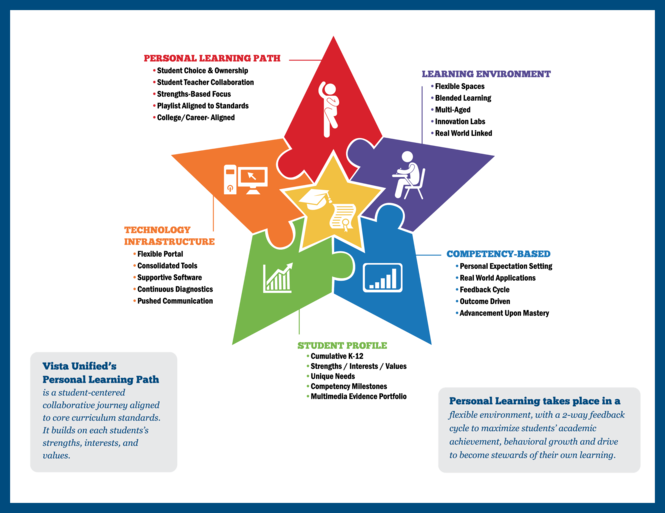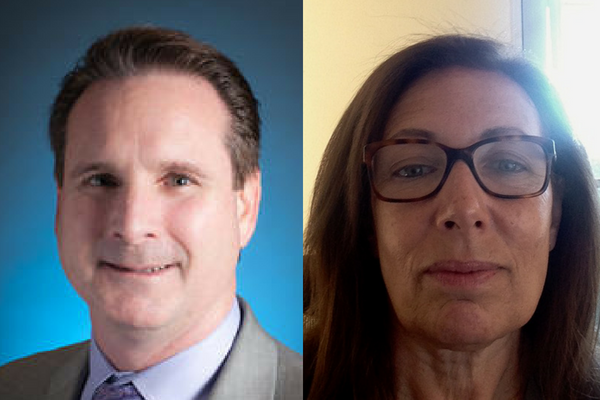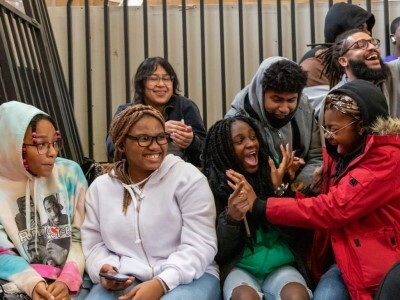Enabling Change
Three Steps Toward Building Vista Unified's Three Brushstrokes
Topics

Next generation learning is all about everyone in the system—from students through teachers to policymakers—taking charge of their own learning, development, and work. That doesn’t happen by forcing change through mandates and compliance. It happens by creating the environment and the equity of opportunity for everyone in the system to do their best possible work.
In just three years, 100 percent of Vista Unified School District schools are transforming to Personal Learning pathways for all students. These three steps made the change possible.
In recent posts, we have introduced the three brushstrokes that guide the transformation of the Vista Unified School District: Early Education, Personal Learning, and Relevant to the World of Work. Personal Learning is the central brushstroke forming our view of a learner-centered approach to education. At Vista Unified, we initiated our school transformation to Personal Learning with a handful of interested schools just three years ago; now 100 percent of our schools are engaged in the process of transforming to Personal Learning pathways for all students.
Transformational change is difficult for any organization, let alone an industry like education—steeped in Industrial Revolution (assembly line) era structures and policies. The focus of this blog is to highlight a series of lessons we learned (and are still learning) during our quest for creating a learner-centered environment that ultimately leads to a more personalized approach to education for all students. Our goal at Vista is students at the center!
STEP 1: Recognize the Magnitude of the Challenge
At Vista Unified, our goal is to create a learner-centered environment that sets the conditions and expectations for adults, as well as students, to engage in continuous improvement—pushing the depth of change beyond technical challenges to adaptive challenges that, if overcome, lead to exponential outcomes for learning. Establishing a system that focuses on students at the center will continuously gather collective efforts to create large-scale forward momentum.
In light of the incredible scope of the shift to a personal approach to teaching and learning, we named this large-scale challenge our "moonshot."
"This is a perfect analogy, not only for its symbolism, but more because, like NASA in the 1960s, much of what is needed to be accomplished is designed as we go along. Personal learning is uncharted territory. Structuring the change process and seeking expert guides helps to keep everyone engaged, excited and moving forward!"
STEP 2: Symbolize the Destination Postcard

We began transformation by going directly to the Vista community of students and parents. We discussed what the ideal future state of learning looked like for students. We discussed what parents wanted to see and hear as students were engaged in personal learning. From these community-based conversations we developed the "Personal Learning Star." The PL Star symbolized our north star, illuminating our moonshot journey. A key design of the change management process was to use this icon as a visual reminder of our collective commitment to transformation. The five elements of the PL Star provide very specific clues to help students, parents, and teachers to visualize the future. In other words, the PL Star served as a destination postcard for our journey.
STEP 3: Raise the Challenge Level
With the PL Star posted everywhere in the district, we created a campaign called the "PL Challenge." In the spirit of personal learning, the PL Challenge was intended as an invitation for school teams to step up to the line and take on the challenge of transforming their schools to become more personalized for all students. This invitation approach taps into the schools' collective sense of autonomy, mastery, and purpose (Pink, 2009). The five elements of the PL Star served as a set of simple rules that schools needed to follow as they took on the challenge. To become part of the PL Challenge, school teams needed to follow a simple application process to demonstrate that they met the conditions necessary to embrace a change management process. The PL Challenge is designed as a three-year process with increasing levels of commitment toward fully implementing the five elements of the PL Star.
- Year 1 PL Challenge Transformation: Defining Your WHY
The change focus during Year 1 of the PL Challenge is to form a PL Design Team that is tasked with defining the "Why" of the school. In order for learning environments to be truly engaging, students and teachers need to have a deep understanding of and commitment to the purpose of the school. We often lead this work with the questions "Why would a parent want to send their child to your school?" and "Why would a student be inspired to come to your school every day?" The process of defining the collective "Why" serves to reset the culture around a learner-centered mindset that becomes the promise a school community makes to students and families. This promise then leads to the new identity or "brand" that differentiates the school from other schools. For example, in Year 1, Temple Heights Elementary defined their purpose as a school that grows great leaders. As result, they even renamed the school to T.H.E. Leadership Academy. - Year 2 PL Challenge Transformation: Defining Your Learning Engine
When schools shift into PL Challenge Year 2 they fully engage the school community in discovery and capacity building around the four attributes of personal learning (Voice, Co-Creation, Social Construction, Self-Discovery; Kallick & Zmuda, 2017). These attributes shift the role of the teacher from the expert of content to the activator of learning—physically moving from in front of students to beside the students as they learn—guiding, encouraging, coaching, and inspiring. In order to operationalize this shift, school teams research and adopt a pedagogical structure or "learning engine" that drives their unit and lesson design and delivery. The learning engine is a key shift away from a traditional approach to education where the textbooks and pre-packaged content control the day and toward a learning process or methodology that is focused on promoting authentic learning. Another key reason for using a learning engine is to ensure that the shift to a personal learning environment is sustainable as teachers and staff come and go. Some examples of learning engines that schools in Vista adopted as part of the personal learning transformation include Design Thinking, Challenge Based Learning, and International Baccalaureate. - Year 3 PL Challenge Transformation: Stake-in-the-Ground
Schools make a formal commitment in Year 3 to start to officially scale-up the shift to personal learning in classrooms. This is what we call putting a "stake-in-the-ground:" committing to letting go of the traditional structures and embracing the four attributes of personal learning, using the learning engine as the vehicle. This transition does not happen in every classroom at once, however. We have defined school scale-up to be at least 33 percent of the students and staff using the learning engine and personal learning attributes during daily instruction. Interestingly, once we see 33 percent on board, the rest seem to follow very quickly. This PL Challenge year also sees significant expansion of collaboration between and among teachers. Peer-to-peer dialogue and coaching become a natural outcome of the school scale-up process. The key shift during Year 3 is that the five components of the PL Star begin to merge together into a collective impact on the learning environment, no longer used in isolation.
While the PL Challenge is currently designed to end at Year 3, we believe that is just the beginning of building our Personal Learning Continuous Improvement Ecosystem. In Transforming Schools: Creating a Culture of Continuous Improvement, Allison Zmuda reminds us that "Transcending the status quo of isolation and moving to a competent system requires continuous improvement..." Building a strong transformation process and continuous improvement ecosystem will ensure that, at Vista, our students are always at the center!




